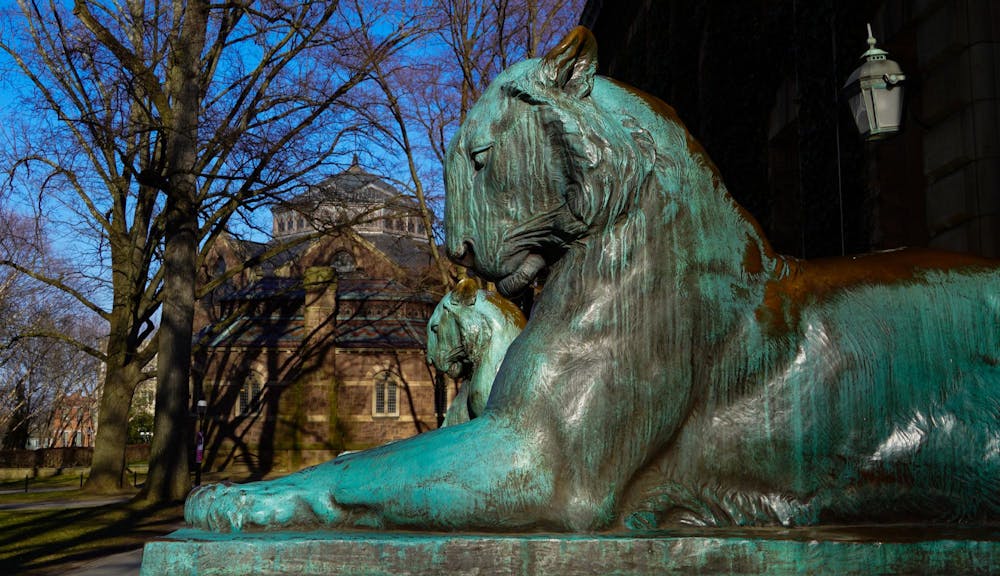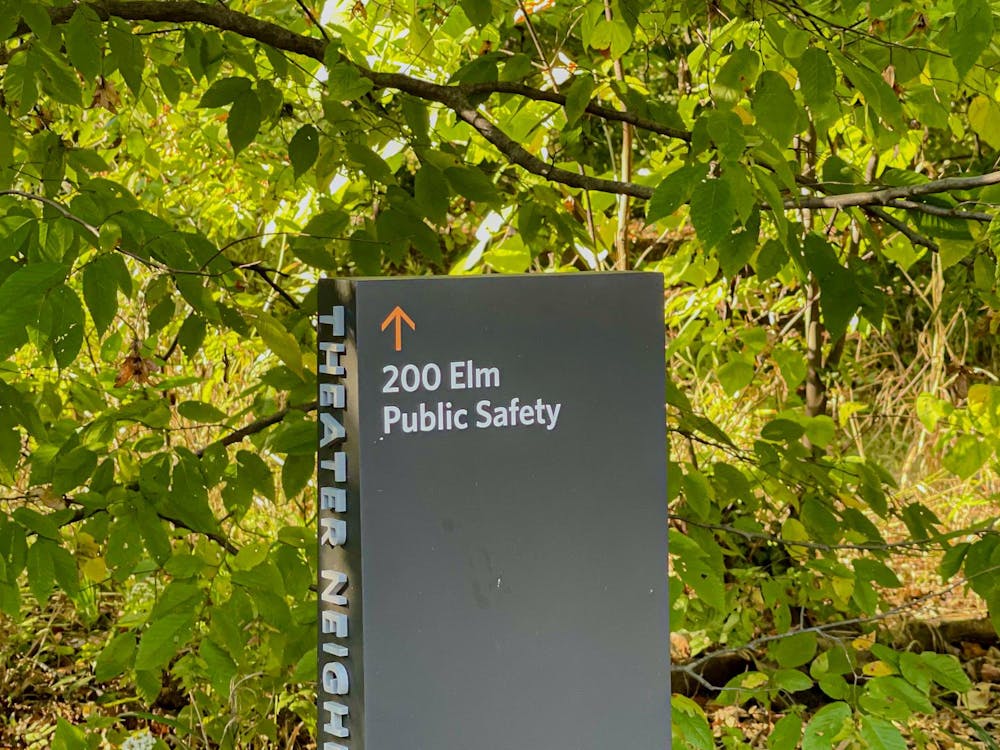Following the release of The Daily Princetonian’s fifth annual Frosh Survey, Data writers and editors analyze and compare the data with other surveys, including past Frosh Surveys and Senior Surveys. This piece will continuously be updated with their analysis on a variety of questions.
Is everyone an engineer now?, Oct. 10
Science and engineering continue to grow at Princeton, as 35.1 percent of first-year students indicated their intent to pursue a Bachelor of Science and Engineering degree in the 2028 Frosh Survey. This is an increase from previous years, where it hovered at around 30 percent of respondents. This is representative of the larger ambitions of the first-year class, with 41.2 percent of respondents considering a career in engineering among other fields after graduation — the second highest post-grad career aspiration after academia.
Three of the five most popular intended concentrations were engineering-based, with 8.4 percent of the incoming class interested in majoring in Computer Science, 7.9 percent wanting to major in Mechanical and Aerospace Engineering, and 7.5 percent planning on pursuing Electrical and Computer engineering. The popularity of these concentrations comes as the University is building a series of new engineering buildings, set to open in Fall 2025.
In a Q&A with the Daily Princetonian last year, University President Christopher Eisgruber ’83 said that his first priority over the next five years is “rebuilding and fortifying our School of Engineering and Applied Science,” because as the field of engineering rapidly expands, the University wants to prioritize having resources and amenities that support the discipline and all those interested in it. More largely, Eisgruber pointed out that having a “great engineering school” is integral to a “great” liberal arts education.
The class of 2028’s interest in engineering reflects the discipline’s increased popularity within Princeton over the past few years. 33.25 percent of the class of 2026 declared a major within an engineering discipline, the second-highest number of engineers since 2017, marking a decrease in humanities majors from 16.7 percent in 2017 to 11.57 percent in 2026. Despite this trend, Eisgruber noted that while the decrease in humanities majors is reflected across Princeton and the nation, the liberal arts curriculum at Princeton ensures that all students are involved in humanities during their time at Princeton.

Increased interest and investment in engineering at Princeton follows a national trend: the number of undergraduates majoring in engineering has sharply increased since 2000. It remains to be seen what this means for the future of engineering education.
Madeline Wadsworth is a staff Data writer for the ‘Prince.’
Differing views between athletes and non-athletes, Oct. 4
Non-athletic regular people (NARPs) and athletes are often thought of as opposing categories of Princeton undergraduates. Comprising 18 percent of the undergraduate population, athletes have dramatically different lives compared to those of non-athletes, structuring their class schedule to accommodate daily meetings and practice times as well as weekly travel.

According to the Class of 2028 Frosh Survey, incoming athletes and non-athletes differ significantly in both their lifestyles and views.
Around 58 percent of non-athletes from the Class of 2028 report having consumed an alcoholic beverage — a smaller percentage than their athlete counterparts, of whom around 78 percent reported the same. This figure is a 10 percent increase from last year: around 66 percent of Class of 2027 athletes reported having consumed alcohol prior to their time at Princeton. On marijuana use though, Class of 2028 athletes are only three percent more likely to have tried marijuana than non-athletes.
Incoming athletes also report having had more sexual experiences on average than non-athletes. Only 40 percent of athletes reported never having sex, compared to over 70 percent of non-athletes.
Athletes have a higher desire to partake in the eating club scene at Princeton, with over 75 percent of athlete respondents indicating that they intend to join an eating club. According to the 2024 Senior Survey, 93 percent of athlete respondents reported being a member of an eating club at the time they graduated, as opposed to 57 percent of NARPs.
Almost 70 percent of non-athletes from the Class of 2028 report being either somewhat or very left-leaning, whereas only around 10 percent identify as right-leaning. For athletes, however, the percentage of right-leaning respondents is higher, at around 35 percent. And while non-athletes from the United States are most likely to have come from the Northeast, athletes are most likely to hail from the South.
Despite these differences, athletes and NARPs take the same classes, complete the same problem sets, and attend the same parties on the Street. The Class of 2028 Frosh Survey highlights these differences and the many similarities between the two groups commonly thought of as different on campus.
Vincent Etherton is a staff Data writer for the ‘Prince.’
Who takes gap years?, Oct. 3
Approximately 7.4 percent of the Class of 2028 Frosh Survey respondents reported that they took a gap year before coming to Princeton. Among students who delayed their entry to the Orange Bubble for a year, structured programs like Princeton’s Novogratz Bridge Year program, proved to be popular, though preferences for how to spend the year varied across household income brackets and high school background.
Of those who took a gap year, the majority (51.9 percent) participated in a structured program during their gap year. This option was particularly popular among students from non-selective public high schools, with 67 percent of graduates from this background who took a gap year choosing this path. Similarly, 57 percent of students from selective public schools and 50 percent from parochial and religious private schools also opted for structured programs.
On the other hand, working during the gap year was the second most common activity, with 27.8 percent of students selecting this option. This choice was most popular among students from independent private schools, where 64 percent spent their gap year focused on gaining work experience before attending college. Traveling was less common, with only 5.6 percent of students reporting that they spent their gap year primarily traveling.
Among students who know their annual household income, gap years were common among students with an annual total household income below $40k, where 11 percent took a gap year. Gap years were also popular among students with incomes of $500k a year or more, with 10 percent taking a gap year. Comparatively, only 4.8 percent of students in the $40-80k household income bracket took a gap year, making them the least popular within this group.
Students with household incomes below $40k who took a gap year tended to work, with just under half of students entering the workplace during their gap year. Among wealthier income brackets, structured programs were the most popular option. 67 percent of students with incomes $125-$250k who took a gap year used the time to complete a structured program and 86 percent of students with incomes above $500k who took a gap year chose this option. As household income increased, the percentage of those who chose to work fell while the percentage of those chose to complete a structured program increased.
The 2028 Frosh Survey shows the valuable opportunity that gap years provide for students to engage in a variety of experiences before entering Princeton. Whether through structured programs, work, or travel, students use this time to gain skills, explore interests, or prepare for the academic challenges ahead — though their preferences for activities during their gap year varied across socioeconomic status.
Hannah Choi is a contributing Data writer for the ‘Prince.’
Patterns in SCEA and legacy admissions, Oct. 2
Single-Choice Early Action (SCEA), a non-binding early admissions process prohibiting students from applying to other private institutions, has long been a distinctive feature of Princeton’s undergraduate admissions process. Among the Class of 2028 Frosh Survey respondents, 38.2 percent were admitted through SCEA. This continues the trend of students being admitted through SCEA, with the exception of the 2020–21 admissions cycle, when the University canceled the early admissions round due to COVID-19.
Meanwhile, the number of students admitted to Princeton through the Questbridge National College Match program increased from 0.8 percent to 9.4 percent for the Class of 2025 and has remained just under 10 percent of the matriculating class since then. The University has partnered with Questbridge since 2006.
For the Class of 2028, only 21.4 percent of students admitted through SCEA gained acceptance from the other Ivy League schools and top institutions listed on the survey. In contrast, 61.2 percent of students admitted during the regular decision cycle and 76.9 percent of those accepted from the waitlist indicated that they were offered admission to other top institutions.
The discrepancy in admission to other universities aligns with data showing that 93.8 percent of students admitted through SCEA reported Princeton as their first choice. While the non-binding nature of SCEA allows students to apply to other universities during the regular decision round, these figures suggest that most students admitted to Princeton early did not take advantage of the process’s flexibility because Princeton was their top-choice institution.
A much higher proportion of legacy and multi-generational legacy matriculants — 63.7 and 65 percent respectively — gained admission to Princeton through SCEA. This trend is echoed as far back as the Class of 2024, which revealed that 75.8 percent of legacy matriculants were accepted early, compared to just 48.8 percent of non-legacy matriculants.
While Princeton does not have an official statement on a preference for legacy applicants, a report by the Ad Hoc Committee on Undergraduate Admission Policy acknowledges a “limited preference” for children of alumni. The authors of the report note that legacy preference “recognizes the University’s special bond with its alumni” — indeed, over 25,000 alumni attend Reunions each year. According to the report, legacy admissions “functions as a tiebreaker between equally well-qualified applicants in limited instances;” the authors concluded that the University should continue to practice legacy preference but “continue to carefully monitor [its] effects and implementation.”
Through SCEA, Princeton admits applicants who have a clear preference for life in the Orange Bubble — and unsurprisingly, many of them claim Princeton heritage.
Hellen Luo is a contributing Data writer for The Daily Princetonian.
Please send any corrections to corrections[at]dailyprincetonian.com.








